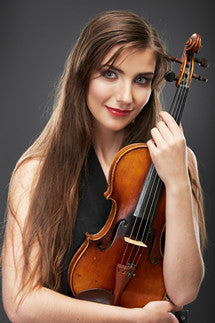
In General
1. Always treat your instrument with love and respect. The great Heifetz would never begin a Master Class if a student left their case on the floor!
2. Heat and extreme dryness cause cracks. Always store your instrument away from heat and above 35% humidity.
3. Never leave your instrument unattended in a car.
4. Avoid touching the hair and loosen the bow after playing. Hold the bow pointing up to protect the white bow tip when you are not playing.
5. Insure your instruments and bows. Visit our website to download a free copy of “Guide to Instrument Insurance” for more information.
6. In case of an accident, wrap any broken pieces in paper and bring them with your instrument to be repaired.
7. If the fingerboard or neck become loose, or the bridge breaks, loosen the strings completely and pad the instrument so the tailpiece or fingerboard won’t scratch the top. And bring it to us as soon as possible!
8. Wipe any liquids that spill on the instrument at once with a soft cloth.
Always After Playing
1. Loosen the hair before putting the bow away.
2. Check from the side that the bridge is straight, leaning a tiny bit away from the fingerboard. It should never be bent in the middle.
3. Wipe the instrument clean with a soft dry cloth. Now and then use some violin polish to remove rosin and grime.
4. Check your strings for wear. Old strings ruin tone and play out of tune.
5. Make sure your shoulder rest is not scratching your instrument.
6. Check the bridge is in line with the inside nicks of the sound holes and centered on the fingerboard.
7. Below 35% relative humidity you must use a humidifier. Check the humidifier and add water if needed.
8. Put the instrument away carefully, and put the case in a safe place.
When Changing Strings
1. Change the strings one at a time. Use tweezers to reach the tight spots.
2. First loosen the fine tuners all the way then tune with the pegs.
3. Lubricate tight pegs with peg compound. Wind each string so it touches the inside of the pegbox.
4. Rub pencil lead in the string grooves in the nut and bridge.
5. New strings stretch and make the bridge bend toward the fingerboard. Straighten it carefully so it contacts the top of the instrument perfectly.
During Orchestra
1. Put your case in a safe place where nobody will trip over or kick it.
2. Most accidents occur in orchestra. Never leave a bow or instrument on a chair, music stand, or the floor. Cellos should be placed carefully on their sides, never dragged.
3. Never rush or let anybody (even a grown-up or teacher) rush you when putting your instrument away. Check the case is fully fastened before you pick it up to prevent your instrument spilling onto the floor.
4. Applaud by tapping your feet lightly on the floor, never tap the music stand with your bow.
At Least Once a Year
1. Have your bow rehaired. Old hair stretches, gets dirty and plays badly. Repair the ivory tip on the head of the bow if broken: it gives the bow-head valuable protection.
2. Bring in the instrument for a checkup. Small problems that you may not see can be taken care of before they become big problems.
3. Brush or vacuum out the inside or your case. Check for any loose trash or exposed metal which might damage your instrument. Check that the bow holders are not weak or broken.
4. Make sure your instrument and bow are insured for their current value.
Taking a Month off?
1. Clean the instrument, bow, and case.
2. Loosen the string tension two whole steps to let the instrument relax while preventing the soundpost from falling down.
3. To keep the bow hair bug away, loosen the bow and put a mothball in the case. Wrap it in a tissue and do not let it touch the instrument or bow directly.
4. Store the case in a cool, safe place – away from heat and excess humidity. A bedroom closet with the door shut is usually a good spot.
One Last Word
1. Always hold violins or violas by the neck, with your thumb and forefinger crossed. The Suzuki method of holding the violin by the upper bout is best for very young beginners only.
2. Cellists should put one hand on the neck and one hand under the upper rib corner.
3. If you notice your instrument doesn’t sound well or becomes difficult to play, bring it in for a check-up at once. Please call us if you are far from home and need us to a recommend a good shop.
4. You should not attempt some jobs which should only be done by a trained expert. These include bow rehairing, changing summer and winter bridges, soundpost adjustments, or regluing any parts that come loose.



Leave a comment